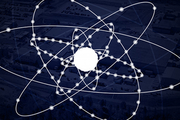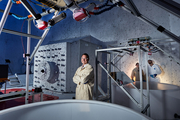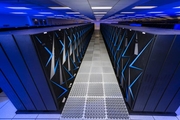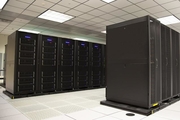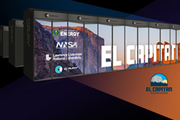New target facility will help unlock plutonium’s secrets
June 10, 2022-
LLNL’s plutonium target fabrication facility includes two large gloveboxes. One houses a diamond turning capability that allows precision machining of samples, particularly for EOS targets. The second glovebox allows expanded sample preparation and assembly and also adds coating capability to deposit layers of interest directly on plutonium, eliminating glue bonds.
Improving our understanding of the physical characteristics of plutonium as it ages is a vital aspect of maintaining the reliability of the U.S. nuclear deterrent in the absence of underground testing. The recent installation of a new plutonium target fabrication facility at Lawrence Livermore National Laboratory (LLNL) aims to further progress toward that goal.
Researchers have developed...
Delivering Exceptional Promise
June 10, 2022-
An Update on Early and Mid-Career Recognition Award Recipients
Lawrence Livermore’s Early and Mid-Career Recognition (EMCR) Program acknowledges the exceptional scientific, technical, and engineering contributions of individuals 4 to 16 years into their professional careers who have made significant mission-critical contributions at the Laboratory. Since the inception of the EMCR Program in...
Polymer Production Enclave Puts Additive Manufacturing on the Fast Track
June 9, 2022-
Since its establishment, Lawrence Livermore has played a critical role in designing components for the Nuclear Security Enterprise (NSE), and more recently, in developing additively manufactured polymer parts to replace aging weapons stockpile parts. Additive manufacturing (AM)—the layer-by-layer technique of printing 3D objects from a digital model—gained traction at Livermore in 2009 after...
Hydrodynamic Experiments Support Stockpile Stewardship
June 8, 2022-
Inside a heavily shielded chamber with 1.8-meter-thick concrete walls, high explosives detonate around a mass of inert test material. Subjected to an intense shock wave, the material briefly acts like a liquid. Advanced diagnostic equipment installed throughout the chamber captures thousands of data points and x-ray images from almost every angle in a split second. The hydrodynamic test—so...
The Sierra Era
Nov. 19, 2020-
This three-dimensional simulation of an idealized inertial confinement fusion implosion shows turbulent mixing in a spherical geometry. Livermore’s Sierra supercomputer makes high-fidelity calculations like this routine, yielding crucial insights into physical phenomena.Lawrence Livermore’s high-performance computing (HPC) facilities house some of the fastest supercomputers in the world, including the flagship Sierra machine. Online for more than a year, Sierra primarily runs simulations for the National Nuclear Security Administration’s (NNSA’s) Advanced Simulation and Computing (ASC) Program. Sierra substantially increases the Laboratory’s ability to...
Lab stands tall on bi-annual list of Top500 supercomputers
Nov. 17, 2020-
Lawrence Livermore National Laboratory (LLNL) can lay claim to housing four of the world’s 100 most powerful supercomputers, more than any other institution according to the TOP500 List announced Monday during the virtual Supercomputing 2020 conference (SC20).
The 125-petaFLOP peak Sierra, the National Nuclear Security Administration’s flagship supercomputer, remained third in the world...
Corona supercomputer gets funding for COVID-19 work
Nov. 16, 2020-
With funding from the Coronavirus Aid, Relief and Economic Security (CARES) Act, Lawrence Livermore National Laboratory (LLNL), chipmaker AMD and information technology company Supermicro have upgraded the supercomputing cluster Corona, providing additional resources to scientists for COVID-19 drug discovery and vaccine research.
The recent addition of nearly 1,000 AMD Radeon Instinct™ MI50...
Partnership to develop NNSA's first exascale supercomputer
Aug. 13, 2019-
The Department of Energy, National Nuclear Security Administration, and Lawrence Livermore National Laboratory announced the signing of contracts with Cray Inc. to build NNSA’s first exascale supercomputer, “El Capitan.”
Read the article.

